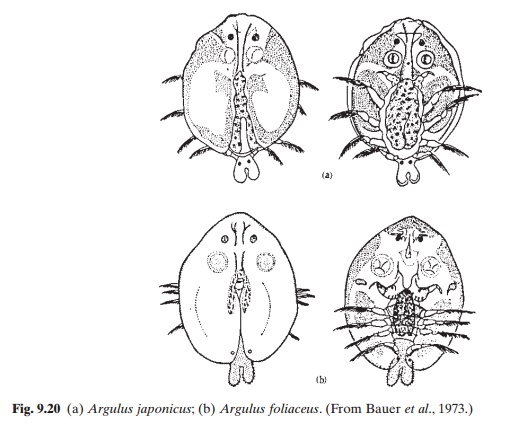Chapter: Aquaculture Principles and Practices: Health and Diseases
Argulosis - Copepod infections of aquaculture species
Argulosis
Argulosis, caused by species of Argulus (fish lice), namely A. foliaceus, A. japonicus and A.giordanii, is one of the most common andwidely distributed external infections of several species of fish including common carp, trout, grass carp, black carp, bream and eel. Out-breaks of argulosis often develop into epizootics, causing mass mortality. Argulus is a large parasite with a wide, oval, flattened greyish-green body (fig. 9.20). The organs of attachment end in curved hooks. There is a suctorial proboscis and suckers on the ventral side and four pairs of swimming legs.

The female of A. foliaceus, which is the most common of the three species, lays eggs on submerged objects in batches of 250–300, which are attached to substrates. Depending on the temperature, the embryonic development takes 15–55 days. The larvae that hatch out swim free in water for two to three hours and die unless they find a host. Eggs die rapidly if they become dry.
Younger fish appear to be more susceptible to infection. Older fish may not suffer from the infection, but would become carriers of the parasite. Because of the lack of host-specificity, Argulus is generally considered a greater risk inaquaculture. It attaches itself to the fish, pierces the skin with its proboscis, injecting a toxic secretion, and sucks the blood of the host. The wound develops inflammation, with profuse secretion of mucus, oedema and haemorrhages. The wound becomes necrotic and the lesion may become secondarily infected. The greater susceptibility of the young ones is ascribed to the fact that the proboscis pierces both the epidermis and dermis, whereas in adults it is able to damage only the epidermis.
Prevention of argulosis consists of isolation of susceptible young fish from older age groups and preventing contact between infected fish and parasite-contaminated water. Ponds should be dried and disinfected after every rearing, to kill the eggs of the parasites. Sticks placed in different areas on the pond bottom can serve as traps for the eggs of the parasites – Argulus would attach eggs to the stick. It is reported that by daily removal of the sticks, most of the eggs can be removed and destroyed (Balarin and Hatton, 1979). Placement of wooden shields in a chess-board pattern for oviposition of Argulus has been suggested by Kiselev and Ivlieva (1953). They suggested removal of the shields every 15–20 days, depending on the temperature, drying them for a day and then replacing them. Effective removal of eggs can thus be achieved. For curative treatment, several chemicals have been recommended, including malathion and dipterex at 0.25 ppm and bromex at 0.12 ppm. Bromex appears to have a greater safety margin. Dip baths of lysol (1 ml lysol for 5 litres water) for 5–15 seconds or potassium permanganate (1 g in 1 litre water) for 40 seconds are also reported to be effective. Fish ponds can be treated with trichlorfon (0.5 g/m3)
for carp and eels or 0.2 g/m3 for more sensitive species, such as trout. If necessary, the treatment should be repeated after two to three weeks.
Related Topics